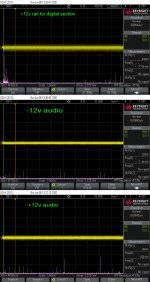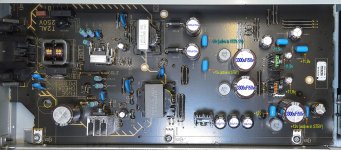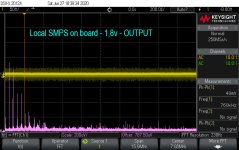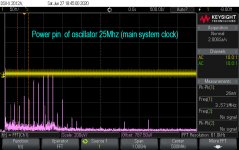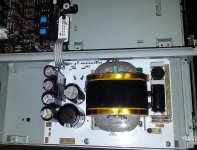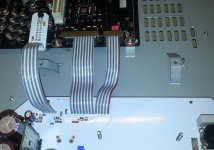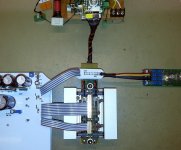Well, Oppo it concluded their players production. So, now one should look for other directions in this field. I appreciate the Panasonic UB9000 as a such possible direction…
This device is in the same price class as last Oppo devices. I decided to take a closer look on this model, appreciating about possible improvements.
I would like to expose here some of my personal appreciations about this device and its functionality, so as it is, out of the production line (and maybe some comparatives with former Oppo models).
I have to mention that I was a little bit unlucky with this UB900 I bought, as it had already and fabrication fault (not powered multi-channel section). I had to spend some time to find out that it was about a abnormal functionality. Quite confusing, when examining for the first-time a (supposedly good functioning) new device. Well, this incident is history now…
First about this model, I remark the very solid mechanical construction. Thick solid steel chassis and enforcement. At least very heavy for its dimensions. The bottom of the chassis is made of a steel plates sandwich, with a total thickness of approx. 3mm. Solid like a tank. Good!
The switching power supply is divided in two sections: one 12v for digital stage, only filtered, and another section of +/-12v for audio section processing (regulated power). The SMPS is a very good quality (in contrast with one of former Oppo models). The HF noise on outputs is very low indeed, for both power sections. Surprisingly, the raw +12v rail for digital section is very well filtered, and its noise is very low. I have not seen before a such low-level HF noise on the outputs of a consumer device SMPS… The +12v for audio section it has a little bit higher noise level, comparing with the other ones (see pictures hereby). The dual +/-12v rails it uses (after a good filtering), two linear standard regulators (7812/7912). These rails it powers the DACs inside and the whole post DAC circuits. However, I can see m any designed places for filtering caps on DACs circuits, which it was not planted… Not good!
Well, Panasonic has chosen a particularly design (nonstandard) for the connection of their SMPS to the main board. Why? Maybe to prevent installing of a different (eventually linear) power supply in their devices… They have maybe seen what happened with Oppo players, and so many models LPS types manufactured for that players. It seems to me that the SMPS connectors for these Panasonic players, it was special designed, to not fit any other standard products or components existent on market.
However, their trial to make unique a such connection, or intention to prevent modding of their devices, is now success less… My LPS for this UB9000 it will have the right connector to fit perfectly into the Panasonic special designed receptacle (user friendly installation) …
The main board of UB9000 is quite small, as the components on it. The main board it includes also two DACs: one for stereo output and another one for multi-channel. What is particular about audio and DAC systems, is the extended use of local linear regulators, for all the power rails of the DAC chips. The digital section it uses small local SMPSes, as standard design also.
The both AKM DAC chips are planted on the downside of the board, which it makes difficult the eventual improvements/measurements. The DACs it are clocked through the digital signals. There are only two clocks on this device: the clock of the main processor (25Mhz oscillator), and a resonator for video chip (HDMI outputs). This resonator is extremely small, I can say.
The main processor is cooled by a quite small heatsink (my opinion), and a fan is also part of the cooling design. This fan is controlled by the thermal circuit build inside the processor. Same bad design as for Oppo 95… The fan is not spinning, but only when the temperature of the whole processor it come up to a certain level. I would like to have the fan running for a much lower temperature level… The processor it works at at above 40 deg.C (measured with open chassis), and the fan is not spinning at all at this temperature. I read in the manual, that the device it has designed and over temperature protection, and therefore it stops functioning if it become too hot. If the fan should run at a lower temperature level, this it will prevent a such overheating protection to stop the whole device. Well, not good in my opinion such functionality.
My already first improvement for this model it was the mounting of a larger heatsink. The fan functionality it will be also modified, but later on…
The small audio board it has on it only post DAC circuits. It is a so-called analogue board entirely. The audio analogue signals coming out of the DAC chips it goes into this audio board. Transistors mute circuits for all outputs. Panasonic it uses lot of film capacitors in the design of the audio section, which is very good also.
On the main board of UB9000 (at least the one I have), is to be seen a designed foot print for a 64 pins chip, which it seems to me in connection with audio stereo stage functionality. A kind of DAC chip maybe, for future upgrades… however, it is not an ESS Sabre chip. This chip is not planted yet on board.
Some impressions about the signal quality out of this device (my perceptions). The picture is very good, comparing with the Oppo stock devices. I am thinking that with the planed improvements, the picture quality issued by this model it can be indeed of an exceptional level.
The sound of the stock device is quite detailed, good sound scene, and good resolution as well, but quite lower output level in my opinion. It seems to me a lack of dynamic somehow, or not as I may prefer also. I know now that AKM DACs it can sound just amazing, so I am very excited to proceed to the necessary improvements to reach the max potential of these DAC chips. Well, the available space for adding components, or replacements, it is a little bit challenging. However, some improvements it is very possible to be implemented.
In my opinion, the software could be better designed (user interface). There are some obvious limitations as I can see, about the versatility of UB9000, comparing with Oppo players, software functionality, user interface, and the more many other files playback compatibilities.
I appreciate the start-up sequence of UB9000 as a pain. Too slow and too many “Please wait”, as other unnecessary messages in between. Oppo said only “Hello”, and the menu screen it was studently up… I expect Panasonic it will improve somehow the firmware, but it seems they are not working or prioritise very much the improving of the software in their last models. Last firmware version is now a whole year old…
The main improvements I can see after a preliminary examination of this device, it may be first an LPS, a better cooling approach, and some extended improvements on audio section/board. I think I will do something about the clock system as well…
I am working right now to finish the LPS for this model (similar approach as for Oppo models).
More to follow…
This device is in the same price class as last Oppo devices. I decided to take a closer look on this model, appreciating about possible improvements.
I would like to expose here some of my personal appreciations about this device and its functionality, so as it is, out of the production line (and maybe some comparatives with former Oppo models).
I have to mention that I was a little bit unlucky with this UB900 I bought, as it had already and fabrication fault (not powered multi-channel section). I had to spend some time to find out that it was about a abnormal functionality. Quite confusing, when examining for the first-time a (supposedly good functioning) new device. Well, this incident is history now…
First about this model, I remark the very solid mechanical construction. Thick solid steel chassis and enforcement. At least very heavy for its dimensions. The bottom of the chassis is made of a steel plates sandwich, with a total thickness of approx. 3mm. Solid like a tank. Good!
The switching power supply is divided in two sections: one 12v for digital stage, only filtered, and another section of +/-12v for audio section processing (regulated power). The SMPS is a very good quality (in contrast with one of former Oppo models). The HF noise on outputs is very low indeed, for both power sections. Surprisingly, the raw +12v rail for digital section is very well filtered, and its noise is very low. I have not seen before a such low-level HF noise on the outputs of a consumer device SMPS… The +12v for audio section it has a little bit higher noise level, comparing with the other ones (see pictures hereby). The dual +/-12v rails it uses (after a good filtering), two linear standard regulators (7812/7912). These rails it powers the DACs inside and the whole post DAC circuits. However, I can see m any designed places for filtering caps on DACs circuits, which it was not planted… Not good!
Well, Panasonic has chosen a particularly design (nonstandard) for the connection of their SMPS to the main board. Why? Maybe to prevent installing of a different (eventually linear) power supply in their devices… They have maybe seen what happened with Oppo players, and so many models LPS types manufactured for that players. It seems to me that the SMPS connectors for these Panasonic players, it was special designed, to not fit any other standard products or components existent on market.
However, their trial to make unique a such connection, or intention to prevent modding of their devices, is now success less… My LPS for this UB9000 it will have the right connector to fit perfectly into the Panasonic special designed receptacle (user friendly installation) …
The main board of UB9000 is quite small, as the components on it. The main board it includes also two DACs: one for stereo output and another one for multi-channel. What is particular about audio and DAC systems, is the extended use of local linear regulators, for all the power rails of the DAC chips. The digital section it uses small local SMPSes, as standard design also.
The both AKM DAC chips are planted on the downside of the board, which it makes difficult the eventual improvements/measurements. The DACs it are clocked through the digital signals. There are only two clocks on this device: the clock of the main processor (25Mhz oscillator), and a resonator for video chip (HDMI outputs). This resonator is extremely small, I can say.
The main processor is cooled by a quite small heatsink (my opinion), and a fan is also part of the cooling design. This fan is controlled by the thermal circuit build inside the processor. Same bad design as for Oppo 95… The fan is not spinning, but only when the temperature of the whole processor it come up to a certain level. I would like to have the fan running for a much lower temperature level… The processor it works at at above 40 deg.C (measured with open chassis), and the fan is not spinning at all at this temperature. I read in the manual, that the device it has designed and over temperature protection, and therefore it stops functioning if it become too hot. If the fan should run at a lower temperature level, this it will prevent a such overheating protection to stop the whole device. Well, not good in my opinion such functionality.
My already first improvement for this model it was the mounting of a larger heatsink. The fan functionality it will be also modified, but later on…
The small audio board it has on it only post DAC circuits. It is a so-called analogue board entirely. The audio analogue signals coming out of the DAC chips it goes into this audio board. Transistors mute circuits for all outputs. Panasonic it uses lot of film capacitors in the design of the audio section, which is very good also.
On the main board of UB9000 (at least the one I have), is to be seen a designed foot print for a 64 pins chip, which it seems to me in connection with audio stereo stage functionality. A kind of DAC chip maybe, for future upgrades… however, it is not an ESS Sabre chip. This chip is not planted yet on board.
Some impressions about the signal quality out of this device (my perceptions). The picture is very good, comparing with the Oppo stock devices. I am thinking that with the planed improvements, the picture quality issued by this model it can be indeed of an exceptional level.
The sound of the stock device is quite detailed, good sound scene, and good resolution as well, but quite lower output level in my opinion. It seems to me a lack of dynamic somehow, or not as I may prefer also. I know now that AKM DACs it can sound just amazing, so I am very excited to proceed to the necessary improvements to reach the max potential of these DAC chips. Well, the available space for adding components, or replacements, it is a little bit challenging. However, some improvements it is very possible to be implemented.
In my opinion, the software could be better designed (user interface). There are some obvious limitations as I can see, about the versatility of UB9000, comparing with Oppo players, software functionality, user interface, and the more many other files playback compatibilities.
I appreciate the start-up sequence of UB9000 as a pain. Too slow and too many “Please wait”, as other unnecessary messages in between. Oppo said only “Hello”, and the menu screen it was studently up… I expect Panasonic it will improve somehow the firmware, but it seems they are not working or prioritise very much the improving of the software in their last models. Last firmware version is now a whole year old…
The main improvements I can see after a preliminary examination of this device, it may be first an LPS, a better cooling approach, and some extended improvements on audio section/board. I think I will do something about the clock system as well…
I am working right now to finish the LPS for this model (similar approach as for Oppo models).
More to follow…
Attachments
Well, this device it have some limitations, comparing it with Oppo, which it was a much more complete multi-media machine. But we do not have anymore Oppo players on market (except some production rests). So, one is somehow forced to chose what it may be available (in the same price class). As I know so far, there is no yet any such device on market, with the Oppo capabilities, and compatibility. This it explain well why the prices of former Oppo (last) models yet still available, it increased so much...
Panasonic UB9000 it can play audio/video files from an attached HDD on its USB3 interface (900mA capable), as to the USB2 interface (500mA capable). Also a NAS it can be used on network interface.
USB DAC option is unfortunately, not available for this model...
Panasonic UB9000 it can play audio/video files from an attached HDD on its USB3 interface (900mA capable), as to the USB2 interface (500mA capable). Also a NAS it can be used on network interface.
USB DAC option is unfortunately, not available for this model...
Some words (and measurements) about UB9k SMPS....
The power supply is divided in two sections: one which it power the main (digital) board, and the second section, which it power the analogue audio stage of the player. The power rail (12v) for the main board is always on. The analogue power rail (+/-12v) it is switched on at device start up. This section it power both the DAC chips as the post DAC circuits.
The SMPS it work at 170kHz and the filtering is quite good, as shown in my first post. However, my design for the linear PSU of this device is finished now...
The power supply is divided in two sections: one which it power the main (digital) board, and the second section, which it power the analogue audio stage of the player. The power rail (12v) for the main board is always on. The analogue power rail (+/-12v) it is switched on at device start up. This section it power both the DAC chips as the post DAC circuits.
The SMPS it work at 170kHz and the filtering is quite good, as shown in my first post. However, my design for the linear PSU of this device is finished now...
Attachments
Ok, thank you.
Regards,
Nick
It can play some but not all.Mine wil play ripped mkv blue rays but not ripped mkv hd dvds.Some mkvs it will only do video but not sound.
Also the usb 3 will recognise a 5tb drive.The usb 2 will not
John
Do you think the digital 12v could be improved by capacitor changes on the psu board ie the three 1500uf and the 3300uf?
I to like you find the please wait messages annoying as well and the fact the 9000 struggles with MKV files.
I am not interested in the audio output.Just helping picture quality and hdmi.
Many thanks
John
I to like you find the please wait messages annoying as well and the fact the 9000 struggles with MKV files.
I am not interested in the audio output.Just helping picture quality and hdmi.
Many thanks
John
Well, one can experiment on this idea... However, the problem of the SMPSes is that may not accept too large capacities on their outputs... It could trigger the over current protection at start up. In this particular case, the start up for 12v rail it happen only when connected to outlet. Else, it may not be necessary too large capacities, as the SMPS it work at 170khz. The designed capacities it is supposed to be enough for filtering out the high frequencies noises. However, residual HF noise may still go through anyway...
My option in this respect, is for a radical improvement here, as replacing the whole SMPS with a linear PSU (concept proved to be very successfully and most efficient in eradicating any of the noises coming from power supply). Noises injected through the power lines it goes deep into the whole system, and it increase the overall noise level of the system as well. So, eliminating the source is the best way of doing, in my opinion.
Another important problem concerning this device, is the lack of interest (finally lack of respect for the users/buyers of the product), from the producer itself (Panasonic), in improving and work out the software of this device. More than a year and no any new firmware version (and the actual version is far from being perfect)... Much of the device possible improvement functionality, it reside in its software. Personally I find very annoying the start up sequence... Too long time waiting until the device is get ready for use, Too many stupid "Please wait" messages.
Remove these unnecessary messages and make things go faster, Panasonic!
My option in this respect, is for a radical improvement here, as replacing the whole SMPS with a linear PSU (concept proved to be very successfully and most efficient in eradicating any of the noises coming from power supply). Noises injected through the power lines it goes deep into the whole system, and it increase the overall noise level of the system as well. So, eliminating the source is the best way of doing, in my opinion.
Another important problem concerning this device, is the lack of interest (finally lack of respect for the users/buyers of the product), from the producer itself (Panasonic), in improving and work out the software of this device. More than a year and no any new firmware version (and the actual version is far from being perfect)... Much of the device possible improvement functionality, it reside in its software. Personally I find very annoying the start up sequence... Too long time waiting until the device is get ready for use, Too many stupid "Please wait" messages.
Remove these unnecessary messages and make things go faster, Panasonic!
Last edited:
Some words about the system clock in this device...
An 25Mhz oscillator it run the main processor, and is also the only clock source for whole system. This oscillator it is powered from an small SMPS on board, used also for one of the processor power rails.
The pictures bellow it shows the noises on 1,8v power rail, at the SMPS output and at the oscillator power pin.
An 25Mhz oscillator it run the main processor, and is also the only clock source for whole system. This oscillator it is powered from an small SMPS on board, used also for one of the processor power rails.
The pictures bellow it shows the noises on 1,8v power rail, at the SMPS output and at the oscillator power pin.
Attachments
Well, one can experiment on this idea... However, the problem of the SMPSes is that may not accept too large capacities on their outputs... It could trigger the over current protection at start up. In this particular case, the start up for 12v rail it happen only when connected to outlet. Else, it may not be necessary too large capacities, as the SMPS it work at 170khz. The designed capacities it is supposed to be enough for filtering out the high frequencies noises. However, residual HF noise may still go through anyway...
My option in this respect, is for a radical improvement here, as replacing the whole SMPS with a linear PSU (concept proved to be very successfully and most efficient in eradicating any of the noises coming from power supply). Noises injected through the power lines it goes deep into the whole system, and it increase the overall noise level of the system as well. So, eliminating the source is the best way of doing, in my opinion.
Another important problem concerning this device, is the lack of interest (finally lack of respect for the users/buyers of the product), from the producer itself (Panasonic), in improving and work out the software of this device. More than a year and no any new firmware version (and the actual version is far from being perfect)... Much of the device possible improvement functionality, it reside in its software. Personally I find very annoying the start up sequence... Too long time waiting until the device is get ready for use, Too many stupid "Please wait" messages.
Remove these unnecessary messages and make things go faster, Panasonic!
Thanks Coris.Best to leave alone then
The picture is great but yes those messages are annoying.
John
The working on UB9000 LPS it still ongoing... Some delays as well...
The out of standard power supply connectors in UB9000, and the impossibility of finding this component as spare part, it is a real challenge in adapting a LPS for this device. Well, I had to build from scratch a connection system for testing purposes, for my LPS for Panasonic UB9000.
I got also the new, and improved PCBs for this LPS. Now, the last step: the assembly and testing the final version of the UB9000 LPS...
The out of standard power supply connectors in UB9000, and the impossibility of finding this component as spare part, it is a real challenge in adapting a LPS for this device. Well, I had to build from scratch a connection system for testing purposes, for my LPS for Panasonic UB9000.
I got also the new, and improved PCBs for this LPS. Now, the last step: the assembly and testing the final version of the UB9000 LPS...
Attachments
- Home
- Source & Line
- Digital Source
- Panasonic UB9000 - discussions, mods, improvements
